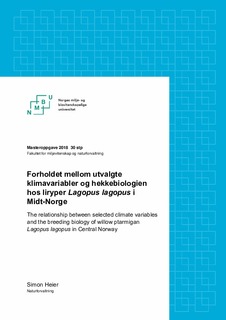| dc.contributor.advisor | Nilsen, Erlend | |
| dc.contributor.advisor | Loe, Leif Egil | |
| dc.contributor.advisor | Moa, Pål Fossland | |
| dc.contributor.author | Heier, Simon | |
| dc.date.accessioned | 2018-10-02T10:59:06Z | |
| dc.date.available | 2018-10-02T10:59:06Z | |
| dc.date.issued | 2018 | |
| dc.identifier.uri | http://hdl.handle.net/11250/2565772 | |
| dc.description.abstract | Globale klimaendringer er godt dokumentert og man ser at de klimatiske rammene endres raskere for arter som lever i høyereliggende områder. Tidligere studier på ryper har vist at hønene i år når våren kommer tidlig kan oppnå bedre kondisjon, øke evnen til omlegging, starte egglegging tidligere og produsere flere egg. For å undersøke eventuelle endringer i hekkebiologien hos lirypa (Lagopus lagopus) har jeg benyttet en 15 år lang tidsserie av individbaserte reirdata fra Dovrefjell. Jeg sammenlignet tre ulike klimavariabler med variasjonen i start av egglegging og antall egg i reiret. Avslutningsvis sammenlignet jeg utvalgte resultater med upubliserte data fra en undersøkelse på liryper i Lierne kommune med individbaserte reirdata over tre år. Hensikten var å undersøke om det eksisterte forskjeller mellom områdene i hvordan hønene responderte på de undersøkte miljøvariablene. Jeg dokumenterte for begge studieområdene at den gjennomsnittlige temperaturen fra 1. april til 30 mai påvirket antallet egg hønene la, men ikke tidspunktet hønene valgte å starte eggleggingen. På Dovrefjell fant jeg i motsetning til tidligere rypestudier ingen effekt av tidspunktet for vårens ankomst på oppstart av eggleggingen. Denne responsen kan være en kostnytte avveining mellom fordelene av tidligere egglegging, og risikoen for værskifter i et høyereliggende fjellområde. Overraskende nok kunne ikke snøforholdene på Dovrefjell i april eller mai forklare hverken tidspunktet når hønene startet eggleggingen eller antall egg lagt. Jeg sammenlignet det første og siste tidspunktet for start av ruging for begge studieområdene, og fant at graden av synkronitet var stor, spesielt for Dovrefjell der den varierte med 15 dager over alle årene. For Dovrefjell-dataen observerte jeg at de voksne hønene tenderte til å ha et mer synkront mønster, i motsetning til ungfuglene som varierte mer i rugetidspunktet. På tross av stor variasjon i synkronitet mellom år, fant jeg ingen mellomårsvariasjon i rugetidspunktet. Aldersgruppen på hønene hadde ingen innvirkning på antallet egg lagt. Denne oppgaven gir støtte for at klimaet har en effekt på hekkebiologien til lirypa. Jeg fant at lirypene på Dovrefjell og i Lierne responderte relativt likt på de undersøkte miljøvariasjonene selv om dataene er registrert med 30 års mellomrom, til en viss grad i ulike habitater og med en relativt stor geografisk distanse. | nb_NO |
| dc.description.abstract | Global climate change is well documented and it is observed that the conditions change faster for species living in higher-lying areas. Previous studies on ptarmigans showed that the hens could achieve higher body condition, increase re-laying, lay more eggs and initiate egg laying earlier with spring advancement. I used a 15-year long time series of individual-based data from Dovrefjell in order to investigate potential changes in the breeding biology of willow ptarmigan (Lagopus lagopus). I compared nine different climate variables with the variation in timing of egg laying and number of eggs laid. Finally, I compared selected results with unpublished data from another survey in Lierne municipality, with three years of similar individual-based data. The purpose was to investigate whether there were differences in the hen’s responses between the areas to the environmental variables I have examined. I observed the mean temperature for both areas between 1st of April to the 30th of May affected the number of eggs laid, but not the timing of egg laying. Unlike previous studies, I found on Dovrefjell that the arrival of spring had no effect for when the willow ptarmigan initiated egg laying. This response could be a trade-off between the benefits of earlier egg laying and the risk of sudden changes in weather conditions in high elevation areas. Surprisingly, could not the snow conditions on Dovrefjell prior to breeding explain the variation in the number of eggs laid or the timing of egg laying. In comparing the first and last initiated incubation for both areas, I found a large asynchrony in the hens timing of incubation, especially on Dovrefjell were the breeding synchrony varied up to 15 days across all years. Despite the wide variety of synchronism, I found no intermediary variation in the timing of incubation on Dovrefjell. The adult hens tended to have a more aggregated pattern in the timing of incubation, where the yearlings varied more in their timing. The age of the hens had no impact on the number of eggs laid. This thesis provides support for climate change does have an effect on the breeding biology of the willow ptarmigan. I discovered that the willow ptarmigans in Dovrefjell and Lierne had the same responsive pattern to environmental variation, despite the 30-year gap between data collection, differences in habitat and the large geographical distance between the areas. | nb_NO |
| dc.language.iso | nob | nb_NO |
| dc.publisher | Norwegian University of Life Sciences, Ås | |
| dc.title | Forholdet mellom utvalgte klimavariabler og hekkebiologien hos liryper Lagopus lagopus i Midt-Norge | nb_NO |
| dc.title.alternative | The relationship between selected climate variables and the breeding biology of willow ptarmigan Lagopus lagopus in Central Norway | nb_NO |
| dc.type | Master thesis | nb_NO |
| dc.source.pagenumber | 25 | nb_NO |
| dc.description.localcode | M-NF | |
